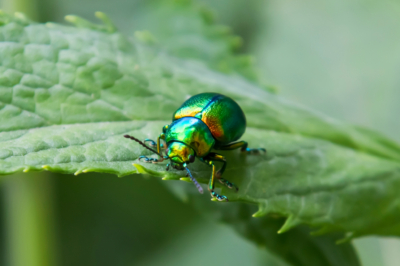Peppermint plants are quite hardy. Even a major pest infestation they cope well. However, you certainly want to enjoy your tea or salad without flesh infestation. Therefore, you should regularly inspect your peppermint for pests.

The most common pests
- Mint leaf beetle
- Aphids
- Black spotted cicadas
- Green shield beetle
- Ground fleas
- Mint leaf beetle
These beetles are not so easy to spot because they are almost exactly as green as the mint leaves. They cause damage by eating holes in the leaves. A mint leaf beetle infestation is not all that bad, because the pretty beetles don’t do that much damage – if there aren’t too many of them.
When is the best time to cut peppermint?
Since you certainly do not want to find the bugs in the tea, just collect them by hand. Clean the crop thoroughly before you process it. If the infestation is very severe, cut off all affected shoots.
Aphids
As with almost all plants, aphids often appear on peppermint.
For light infestations, remove the aphids by hand or rinse them from the leaves with a sharp stream of water. For stubborn infestations, nettle manure, tobacco broth or soapy water will help.
Black spot cicadas
You can recognize an infestation when the leaves become thin and appear to wilt, because the cicadas suck out the leaf sap.
Picking them off usually does little good. Cut off infested shoots. In the fall, remove the entire plant and plant new peppermint elsewhere.
Green shield beetle
It lays its eggs in the leaves of peppermint. Larvae and beetles eat large holes in the leaves. It is best to collect the beetles in the morning. Then they are still clammy and not so mobile.
Earth fleas
The little beetles stay mainly on the ground under the plants. You will notice the infestation because the peppermint leaves have small holes. Hoe the soil regularly. This will drive the beetles away.
Tips & Tricks
If you can’t get the pest infestation under control, consider pulling out the peppermint and growing new plants. This definitely makes more sense than using chemicals to control pests.









